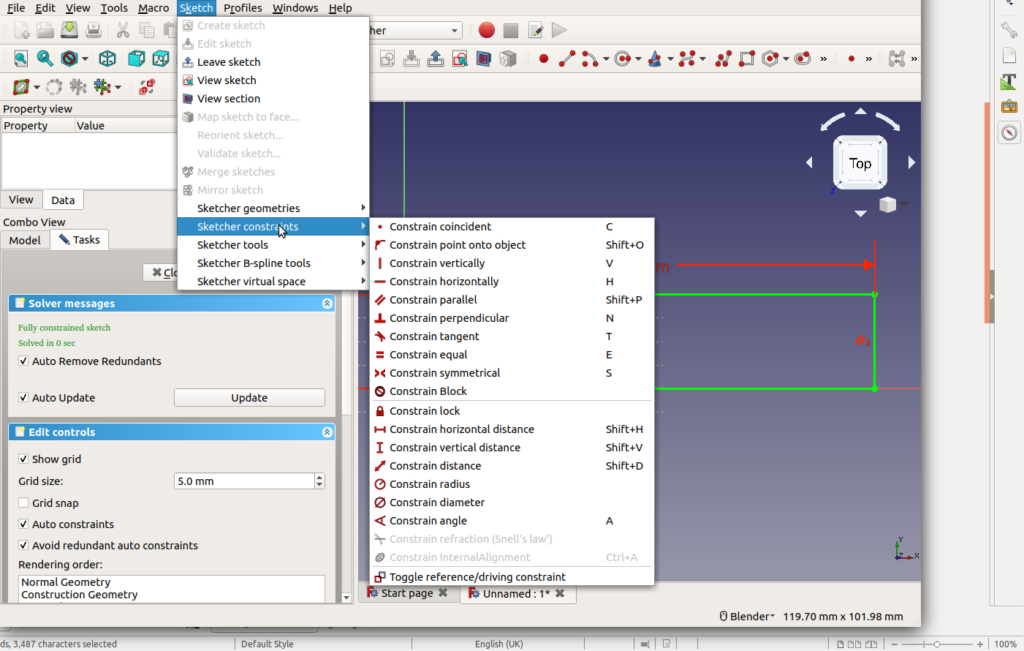
Limitations Īs of v2.1., SolveSpace reference lists a disclaimer on limited support for NURB-surface Boolean operations which may occasionally fail. Linux specific libraries include gtk-3, Gio, and X11. SolveSpace depends upon ANGLE, OpenGL Utility Library, zlib, libpng, libdxfrw, cairo,, mimalloc, libsigc++ and some other C++ libraries, as well as freetype2, harfbuzz, and Pango for text rendering. In order to verify a newly modeled concept in SolveSpace, users can "link" all the components and constrain them at specific positions to check whether the virtual end-product meets the original concept's design and constraints. It is also possible to draw a workplane on a specific "surface" of another 3D model the surface is usually indicated by two line segments joined by a point. Created 3D models can also be further constrained with the basic tools mentioned above or combined with another one by Boolean operations. Every group in SolveSpace encapsulates an action applied to the specified sketch created for every 3D operation, such as an extrusion, rotation, or translation. An extruded model creates a group along a specified normal. When sketching is complete, a 3D part can be extruded into a volumetric model for further modeling. The radius of a circle, for instance, can be constrained to a specific value, or can be influenced by some other entity dimension.

Constraints Ĭonstraints include dimension limitation, angle, paralleling with another line, tangency, point, symmetry and alignment of a line with origin axes (to make them "vertical" or "horizontal").
#LIBRECAD CONSTRAINTS SOFTWARE#
There are no software limitations for the number of workplanes user can create. SolveSpace can split intersecting entities via a separate tool. Users can make it active and draw basic primitives such as lines, circles, arcs, dots, and other points of references on the workplane, and constrain them to specific dimensions and relations. A workplane is plane with an origin for the new sketch where the SolveSpace draws entities. Modeling in SolveSpace is done by way of sketching in a workplane. When the model is complete, it is either exported to one of the supported CAD formats or into a document for further processing. The basic shapes of a new physical part is sketched out and constrained to specific dimensions and locations. SolveSpace workflow starts either with opening an existing file or creating a new one and usually involves sketching. SolveSpace is able to export models in STEP, STL, and G-code for reuse in third-party CAM software. Polygon meshes can be exported as STL and Wavefront OBJ NURBS as STEP. Wireframes can be exported as DXF and STEP files. SolveSpace v3.0 is able to export 2D sketches and surfaces into DXF/DWG ( AutoCAD version 2007), PDF, SVG, EPS, and HPGL file formats. The DXF/DWG file format AutoCAD (version 2007) is supported for opening and editing. SolveSpace can open and import its own textual *.slvs file formats for both editing and assembly. In 3D it is possible to use basic Boolean operations (union, difference, intersection), though as of version 3.0, SolveSpace had limitations on the order of application of these operations. 3D Solid Modeling Drawing, extrusion, rotation and revolution along a helix are supported in both modes. SolveSpace is shipped with the following basic features: 2D Sketch Modeling SolveSpace supports parametric 2D drawing of lines, circles, arcs, Cubic bézier curves etc datum points and lines are also supported for general, reference based modeling.

#LIBRECAD CONSTRAINTS FREE#
SolveSpace is free and open source software distributed under the GPL-3.0-or-later license. On September 22, 2020, Whitequark stepped down as a maintainer with the possibility of occasional contributions.
#LIBRECAD CONSTRAINTS CODE#
The codebase at the time was about 30,000 lines of code and it took Whitequark almost 2 years to familiarize herself with it. In an 2020 interview article with a major maintainer named "Whitequark", SolveSpace was described as being very conservative in terms of backward compatibility. A previous software package called SketchFlat, also developed by Westhues, was replaced by SolveSpace. Development of SolveSpace started in 2008.


 0 kommentar(er)
0 kommentar(er)
